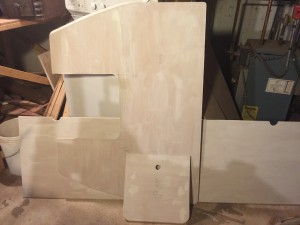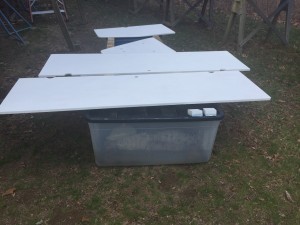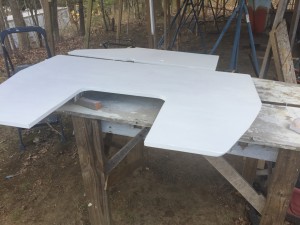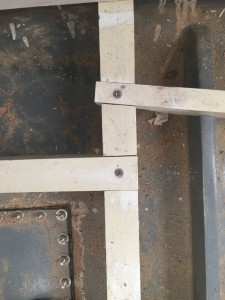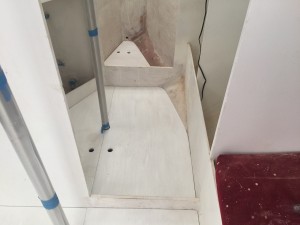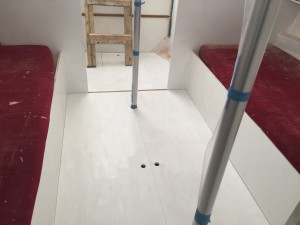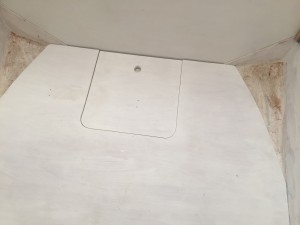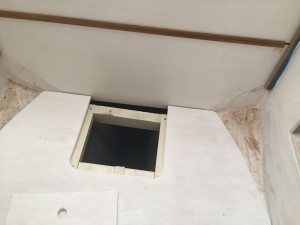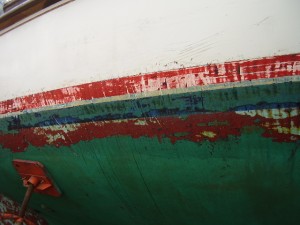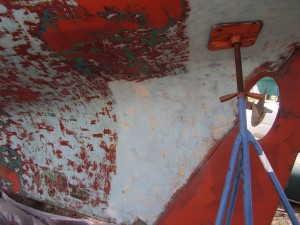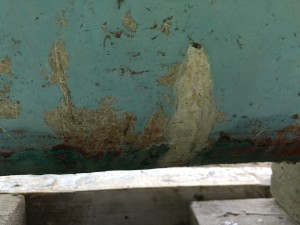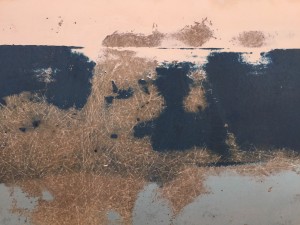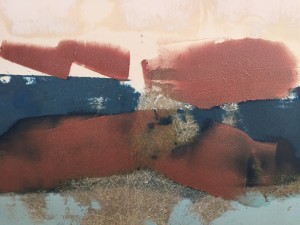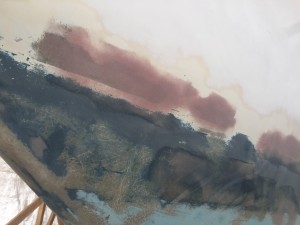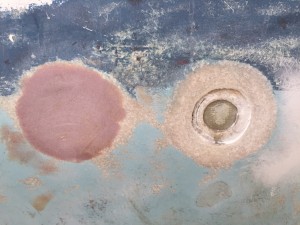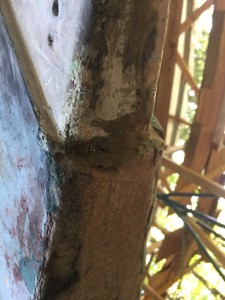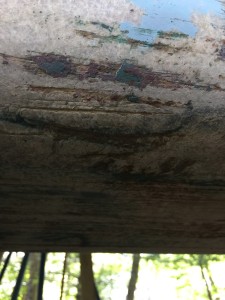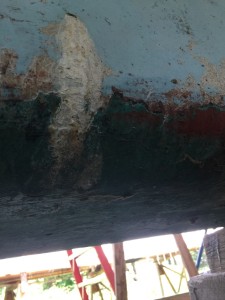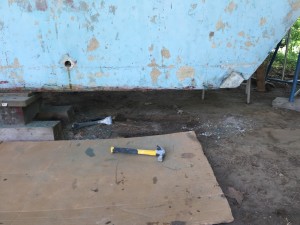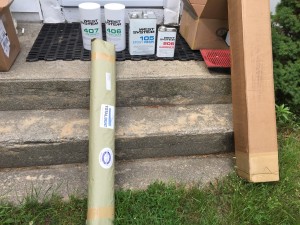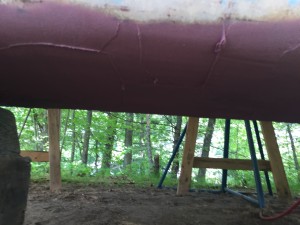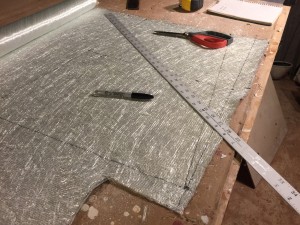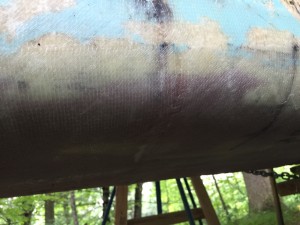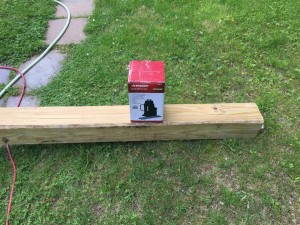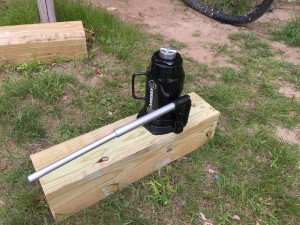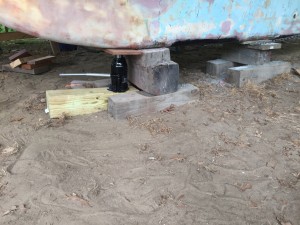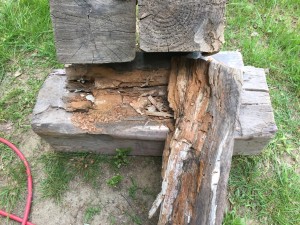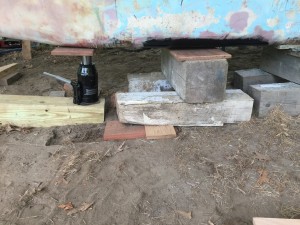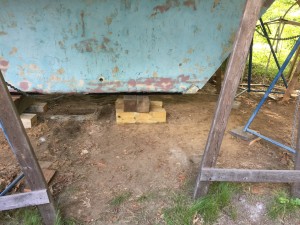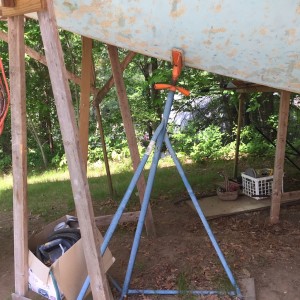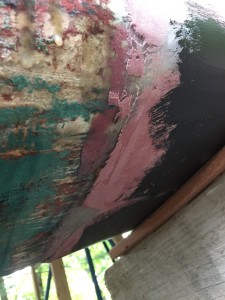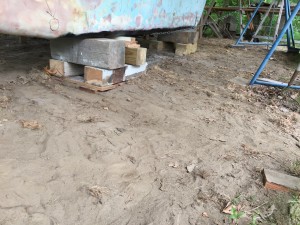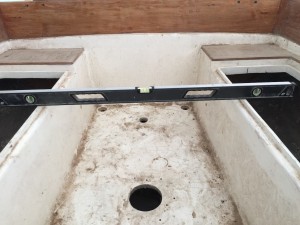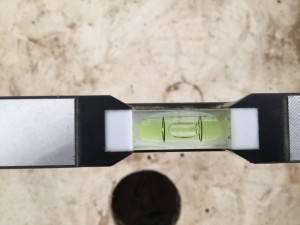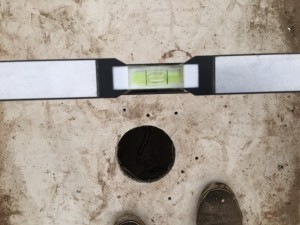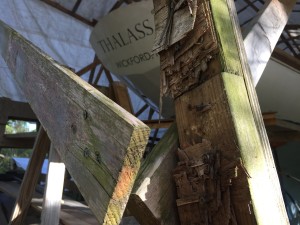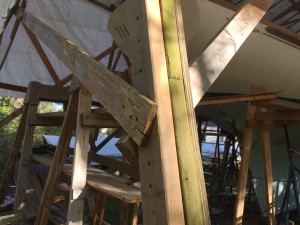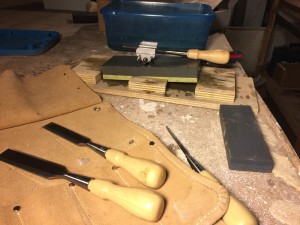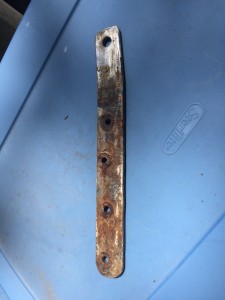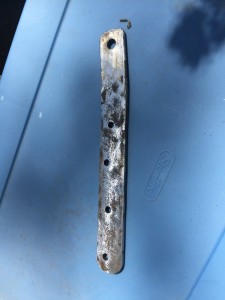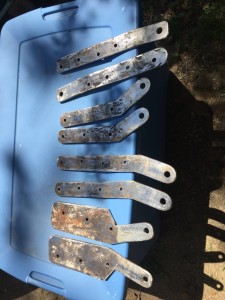6/7/18: Floors, Keel, Misc.
Click HERE to read about the work on the cabin sole back in October 2017. The work continued this year with the application of two coats of primer.
Eventually I will apply a non-skid coating to the sole, but for now, considering all of the work still to do in the cabin, I decided to wait. In the mean time, I screwed the floor beams together at the appropriate joints.
In the following photos, you can see where I have made finger holes for lifting the boards.
Back aft, I made a cutout for easy inspection of the bilge.
Meanwhile, I started thinking about the bottom. The following photo was taken in 2007, just weeks after purchase. I had begun removing the bottom paint, thinking that I would strip it all the way down. Under the many layers of paint, I discovered that the original bootstripe was lower than the current, and that the newer, higher, green bootstripe was originally red.
I soon realized the magnitude of work required to remove all the bottom paint, and I abandoned that job. I prepped and painted the topsides, then added a fresh coat of bottom paint. When the total restoration began in 2010, I finally stripped the bottom down to the glass and gelcoat. The following photo, from 2010, shows some of that work underway.
An ever-present concern related to fiberglass boats is osmosis of water into the hull below the waterline. Slowly, molecule by molecule (never as liquid), water passes through the gelcoat and collects in voids and pockets in the laminate. (The term “laminate” here is used as a noun, and simply means the layers of fiberglass in the hull.) The absorbed water can react with constituents in the laminate (hydrolysis), possibly forming blisters. A bad case of osmosis can compromise the structural integrity of the hull.
Recall that Thalassa has internal ballast–that is, the concrete/lead ballast is encapsulated in fiberglass. (The popular alternative to internal ballast is a bolted-on lead keel.) About four years ago, I drilled a few holes through the fiberglass into the keel and found that there was some water in the keel. As a result, I drilled about 20 holes in strategic locations to allow the water to drain and the laminate to dry out. The following photo shows one of the holes and the white stuff is the crusty, dried-up remnant of whatever has drained out over the years.
Now, four years later, I want to begin finishing the bottom, but I need to know if the hull is dry before applying barrier barrier coats and paints and other layers that would simply trap the water in the laminate. I contacted a surveyor, and hired him to check the moisture levels of the hull and deck with a moisture meter. His moisture meter is a small, hand-held device that lookes something like this:
He found that the moisture levels in the hull and deck are acceptable everywhere. Where I recored the deck in 2012, the deck is bone dry. Everywhere else on the deck and hull the levels are mostly very dry, with a few moist spots. The surveyor recommended no further action, which gives me the green-light to move forward with refinishing and repairing the bottom of the boat. (Incidentally, he also inspected the rudder and found that it was totally dry.)
At one time, I think a previous owner had the gelcoat stripped from the bottom and the bottom is currently a patchwork of bare fiberglass an a blue-colored barrier coat.
I began near the boot stripe, using fairing compound (epoxy, thickened with low-density filler) to smooth out the hull where it was slightly irregular.
This is an iterative process that will continue for many weeks. Eventually I will post “after” photos. At the same time, I’ve continued to patch up the original through-hull holes. The patch on the left is completed. The one in the right requires more grinding, layers of fiberglass, then filling and fairing.
Another concern is the bottom of the keel, which for Thalassa is about 10 feet long, flat, and about 18″ wide at its widest point. Boats “on the hard” typically sit on blocks, on which the full weight of the boat rests, while the boat stands simply balance the boat and bear no significant loads. The boat owner can access the part of the keel away from the blocks, and typically addresses the inaccessible places while the boat is “in the slings” just before launch.
With these thoughts in mind, I took a look at the bottom of the keel. Here is the aft end, which is the narrowest part:
Here are some places further forward:
In 40+ years of sailing, the bottom of the keel, while in very good shape overall, has seen plenty of scrapes, gouges, and many layers of bottom paint. I decided to totally refinish the bottom of the keel with two layers of fiberglass and a coat of antifouling paint. In this way, there will be no work to do while the boat is “in the slings” next summer (hopefully).
Thalassa’s keel sat on three sets of blocks, and I found that all the weight was on the forward two sets, so I was able to easily remove the aft-most set, providing more access to the bottom of the keel.
In the complete restoration of a fiberglass boat, one looks forward to the day when there are no more big fiberglass layups to do. That day never comes.
I began by scraping off any remaining bottom paint, heavy sanding, and then filling with fairing compound.
Next, I took measurements and planned the layup schedule.
Then I laid up the two layers of glass.
More sanding, fairing compound, and sanding, then a coat of bottom paint (these steps not shown).
With the accessible areas finished, it was time to move the blocks. Some of the existing blocks, I could tell, were rotting, so I bought a pressure-treated 6×6, which I cut into four two-foot lengths.
The 44,000-lb bottle jack will be used to jack up the boat from the keel.
Recall that I have already removed the aft-most blocks, so jacking up the front of the keel simply pivots the boat on the middle blocks.
Little by little, I jacked up the forward end of the keel while simultaneously adjusting the boat stands (lowing those aft, and lifting those forward). Eventually, I was able to remove the forward blocks, and you can see here that they have suffered over the years.
Next, using good blocks, I built up a stack under the finished part of the forward end of the keel.
I added a stack to under the finished part of the aft end of the keel, then with a little more jacking up of the forward end, I was able to remove the middle set of blocks.
I don’t expect that many of you are trying this at home, but a word of caution anyway. After removing the jack (again, little by little, while adjusting the stands) I found that there was quite a bit of weight on the forward “V” stand.
I realized immediately that by moving the forward blocks aft, I had inadvertently created a situation in which the center of mass of the boat was forward of the forward-most block. Thus, the forward stands were supporting some of the weight of the boat, not simply balancing the boat. While this was not a dangerous situation, I kept the jack under the forward end of the keel while I was not working.
Back to the job at hand, here is a photo showing the transition from finished to unfinished.
Sparing the details, I finished the unfinished parts of the bottom of the keel and moved the blocks around again.
As a final step, I checked to see of the boat was level.
It was not quite:
A few turns of the stands brought the boat into level:
Meanwhile, I inspected the frame and did a few minor repairs…
…sharpened my chisels…
…and cleaned up the mizzen and backstay chainplates. Much more on that later.
